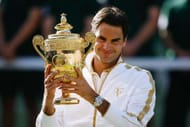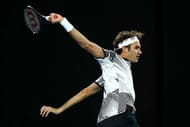2-3 down in the fifth set, going up 0-40 on Nadal’s serve and then allowing the Spaniard to make it 40-40. Roger Federer was not playing Rafael Nadal’s heavy topspin forehands in Melbourne the other night. He was playing against his own demons.
The old scars of having held all the aces, and then allowing his nemesis a crack through the door through which he rammed home a bulldozer, were beginning to show for the grand old maestro. All the accusations of being a great front-runner in the game who would crumble when exposed to relentless pressure must have been haunting his brows, weighing on his steps, putting doubts into his single-handed backhand again.
But just when you thought it would be the same old blueprint, the Swiss came back with some outrageous shot-making and some incredible fortitude. Defeating decade-old mental demons, Federer reversed all the post-mortems done on his DNA.
The Swiss beat his most fearsome foe Rafael Nadal over five sets and after being down a break. People who thought they had tennis characters figured out were left a little puzzled, and a little willingly-suspended-in-their-disbelief at this stranger-than-fiction event.
How did it happen? Let us look a little closer and try to detect patterns in the tale.
Federer intended his tale to be a saga, and not just a perfectly packaged short romance. Of that there can be no doubt. A keen observer would be able to choreograph all the chapter-divisions in his career. Let us recollect the number of stereotypes he’s managed to ruffle:
Mercurial talent, dominant champion, fading veteran, resurgent warrior, near-oblivion to late career dazzle

The mercurial talent that never did justice to his prodigious abilities, matured into one of the most dominant champions that tennis had ever seen. If he retired by the end of 2009 with 15 Slams including the French Open, the world would have recognised a perfect fairytale.
He would have still been the quasi-mystical near-wizard with a complete all-court game, and Nadal would have still been an aberration. But Federer forced himself to fight through the next decade as well. In the process, he encountered semifinal and final defeats and the emergence of a new champion in Novak Djokovic, before he finally clinched the 2012 Wimbledon trophy.
2013 saw him turn out the worst performance of his life, and tales of a back injury spelt the demise of his aura. However, the champion came back with a bigger racket head and a fitter body and made it to three Slam finals in the span of 2014-15, though falling woefully short to the Serbian Djokovic each time.
The uncharacteristic knee injury that pushed him out of the game (and out of a Slam for the first time in 16 years!) for nearly six months, almost sounded his death-knell. But he came back once again, and capped it with his 18th triumph in Slam finals.
As composed as Bjorn Borg – a champion who does not reveal his emotions on court
Today, Federer is widely lauded for his ability to remain calm under pressure, and his lack of overt displays of emotion on the court. And yet it wasn't always like this.
The graceful legend was once one of the most short-tempered players around, known as much for his bad behaviour on the court as for his silken touch. But by the time he stepped into the perimeter of a seriously global radar, the ace player evolved into one of the most stoic and cool avatars the game would witness.
Again, this trajectory would not remain flat over the course of his career. 2008 was considered to be the first challenging year after his near invincible streak of the previous four. Federer’s ‘resurgence’ saw him become a lot more verbal. The ‘sugar and spice and everything nice’ image also wore off as we saw the more combative aspects of his persona.
In the last few years, the man has given us enough expressive vents on-court to challenge the unilateral notions about his stoicism.
Federer's backhand is weaker than the likes of Wawrinka, and creates a unique vulnerability for him in big matches
It's no secret that Federer's backhand is the weakest part of his game. And yet we have seen with our own eyes how progressively better he has become with the shot towards his late career (by his own admission). When everyone thought his game was perfect, he realised where Nadal had exposed his chinks. He didn’t get swayed by either the accolades or the criticism, and instead simply worked to get better.
The gorgeous and fearless backhand drives that earned him so many points on Sunday, were a result of striving hard to convert a potential weakness into a weapon. His admission about how the Spaniard helped improve his game, was reinforced many times over during the final in Melbourne.
After all, this late improvement and increased confidence in his backhand have seeped into his performance against other players too in the big moments!
A great front-runner but not as great in comebacks, especially against players who’ve got his number
Again by own admission, the Swiss was a talent-dependent player who would crumble when the opposition applied pressure. And so early in his career the trick was just to hang around with him long enough for him to defeat himself.
Although he rectified this abundantly through his career, enough instances were presented to us of how he could easily revert to type. When broken early on in pressure games against his biggest opponents, Federer has often checked out mentally, thus blocking his own comeback into the match.
Several examples can be cited here: the Wimbledon final of 2014 and US Open final of 2015, as well as the WTF final of 2015 against Djokovic. We can also add the fifth set defeats to Nadal in SW ’08 and AO ’09. Coming back from a break down in the fifth set against the iron fortress called Nadal was the ultimate challenge in this respect. If he could pull off that, then he would have vanquished the final frontier – the frontrunner would have graduated into the marathon battler.
Parallels in this respect can be found with Indian cricketer Sachin Tendulkar’s career as well. The matches that the Little Master won in Australia in 2008 as well as the victory against England in Chennai 2008, finally proved his credentials of being a match-winner under pressure.
Epic prose
From analysing these patterns we can see that champion players give us multiple dimensions through which we can dissect their greatness. Federer's greatness doesn't lie merely in his all-court near-perfect game or in the grace of his movement. Sure, they embellish his aura. But Roger Federer transcends poetic perfection or short-lived fairytales.
The true fabric of his halo lies in his evolution into a comprehensive character, a man who rose beyond his talents and showed us that he’s one for the longest races against Time, someone with his footmarks on every threshold – stern or glorious.
He has embraced life in all its prosaicness, with its brutal realities, its ups and downs, its silent confinements away from eulogies and bugles. He has accepted tennis to be an extension of life itself. And in this lies his story.
Who Are Roger Federer's Kids? Know All About Federer's Twins


